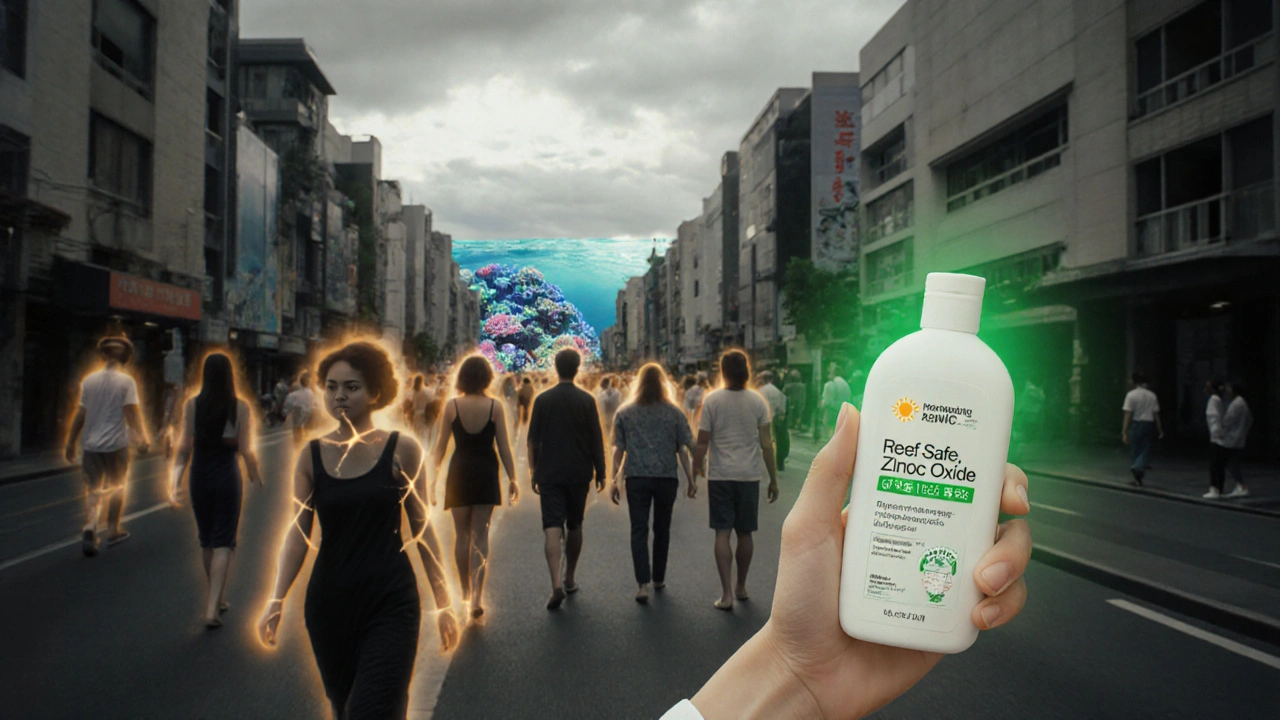Most people think sunscreen is just about avoiding sunburn. But if you’re only using it at the beach or on a sunny day, you’re missing the point. UV damage doesn’t wait for clear skies. Even on cloudy days in Melbourne, UVA rays slice through clouds and glass, quietly breaking down collagen, triggering dark spots, and increasing your risk of skin cancer. This isn’t hype-it’s science. And the numbers don’t lie.
What SPF Actually Means (And Why Higher Isn’t Always Better)
SPF stands for Sun Protection Factor. It measures how well a sunscreen blocks UVB rays-the ones that burn your skin. An SPF 30 product means it takes 30 times longer for your skin to burn compared to wearing no sunscreen at all. Sounds simple, right? But here’s where most people get it wrong.
SPF 15 blocks 93.3% of UVB rays. SPF 30 blocks 96.7%. SPF 50 blocks 98%. That’s it. There’s no magic jump from 96.7% to 100%. The difference between SPF 30 and SPF 50 is just 1.3% more protection. Yet, SPF 50 products cost more, feel heavier, and often contain more chemicals. Why? Because marketers sell numbers, not science.
The real issue? Most people apply only a quarter of the amount needed. Dermatologists say you need about 1/4 teaspoon for your face. If you use half that-like most do-you’re not getting SPF 30. You’re getting the protection of SPF 7.5. That’s why experts recommend SPF 30 or higher: it gives you a buffer for under-application. SPF 50 gives you a slightly bigger buffer, but not a massive one.
UVA vs. UVB: The Hidden Enemy You’re Probably Ignoring
UVB rays are the burners. They hit the top layer of your skin, cause redness, peeling, and directly damage DNA. That’s why they’re linked to melanoma and other skin cancers.
But UVA rays? They’re the silent destroyers. They make up 95% of the UV radiation that reaches Earth. They penetrate deeper-past the epidermis, into the dermis-where they break down collagen and elastin. That’s what causes wrinkles, sagging, and age spots. UVA rays don’t burn. They don’t even make your skin feel hot. But they’re working 365 days a year, even when you’re driving to work or sitting by a window.
Here’s the kicker: SPF only measures UVB protection. That’s why “broad spectrum” matters. A sunscreen labeled broad spectrum means it also protects against UVA. The FDA requires these products to pass a critical wavelength test-meaning they must block UVA rays down to at least 370 nanometers. And the Skin Cancer Foundation now requires that UVA protection be proportional to the SPF. So if you’re using SPF 50, your UVA protection should be strong enough to match it. Not just “kind of there.”
Mineral vs. Chemical: Which One Actually Works Better?
There are two main types of sunscreen: mineral and chemical. They work in completely different ways.
Mineral sunscreens (also called physical) use zinc oxide and titanium dioxide. These sit on top of your skin and reflect UV rays like a mirror. They start working immediately. They’re less likely to irritate sensitive skin or cause breakouts. That’s why so many people with acne or rosacea swear by them.
But they have a downside: white cast. Especially on darker skin tones. That’s why brands like La Roche-Posay and CeraVe have spent years reformulating to make micronized zinc oxide less chalky. Some now use tinted versions that blend in. Still, if you’re used to chemical sunscreens, it can take a few weeks to get used to the texture.
Chemical sunscreens use ingredients like avobenzone, octinoxate, and oxybenzone. They absorb UV rays like a sponge, convert them into heat, and release them. They tend to feel lighter, spread easier, and don’t leave a white cast. But they need about 15 minutes to activate after application. And some ingredients-especially oxybenzone-can trigger irritation, stinging eyes, or even breakouts in acne-prone skin.
Reddit users in r/SkincareAddiction report that 78% of people with sensitive skin had fewer reactions switching to mineral. But 63% complained about the white cast. On Amazon, top-rated sunscreens like La Roche-Posay Anthelios SPF 50 have over 8,700 reviews-with users praising “no white cast” formulas. That tells you something: technology is catching up.

Water Resistance, Reapplication, and the 2-Minute Rule
“Water resistant” doesn’t mean waterproof. The FDA defines it as either 40 or 80 minutes of protection while swimming or sweating. After that, you need to reapply. And here’s the thing: even if you’re not swimming, you’re still sweating. Walking to the train, sitting in the sun during lunch, biking to the store-all of it chips away at your protection.
Reapply every two hours. That’s the rule. But most people don’t. A 2023 study by the American Academy of Dermatology found that 90% of users apply too little. And that’s why SPF 30 becomes SPF 15 in real life.
Here’s a simple trick: Apply sunscreen as the last step in your morning skincare routine-after moisturizer, before makeup. Let it sit for 15 minutes. If you’re using a chemical sunscreen, this gives it time to absorb. If you’re using mineral, it helps it settle without pilling under foundation. And if you’re wearing makeup? Use a sunscreen powder or spray for touch-ups. Don’t just rub it over your concealer-that’s not protection. That’s theater.
What the Experts Are Saying (And Why They’re Pushing SPF 50+)
Some European dermatologists argue that SPF 30 is enough. They say the extra protection above that is negligible. And technically, they’re right. But American dermatologists are pushing for SPF 50+ for one reason: real-world behavior.
Dr. Rahman from Stanford Medicine puts it bluntly: “People apply too little. So we give them a higher SPF to compensate.”
The Skin Cancer Foundation updated its Seal of Recommendation in 2023. Daily use products now need SPF 30+ (up from 15). Active use? SPF 50+ (up from 30). Why? Because research shows UVA damage accumulates over time. Even brief, daily exposure adds up. And in places like Melbourne-where UV levels are among the highest in the world-this isn’t optional.
Dr. Leslie Baumann, a leading cosmetic dermatologist, says this: “UVA rays are equally intense at 8 a.m. and 4 p.m. They go through windows. They’re there in winter.” That’s why daily use isn’t a suggestion. It’s a medical necessity.

The Future of Sunscreen: Blue Light, Reef Safety, and New Regulations
The sunscreen industry is changing fast. In June 2024, the FDA announced new rules: by December 2025, all sunscreens sold in the U.S. must clearly label “broad spectrum” on the front. Products that don’t meet the standard will be pulled from shelves.
Also, the FDA is considering capping SPF labels at “SPF 60+” because higher numbers mislead people into thinking they’re getting near-total protection. Spoiler: they’re not.
Reef safety is another big shift. Oxybenzone and octinoxate have been linked to coral bleaching. Hawaii and Key West have banned them. Many brands now label their products “reef-safe.” That usually means avoiding those two chemicals and using non-nano zinc oxide instead.
And it’s not just UV anymore. Dermatologists are starting to look at blue light from screens and infrared radiation. A 2024 survey found 68% of dermatologists expect multi-spectrum protection to become standard within five years. That means sunscreens might soon protect against more than just the sun.
What to Look for in a Daily Sunscreen
Here’s what actually works, based on science and real user experience:
- Choose broad spectrum SPF 30 or higher-no exceptions.
- For sensitive or acne-prone skin: try mineral sunscreens with zinc oxide. Look for “non-comedogenic” on the label.
- For everyday wear: go for lightweight, non-greasy chemical formulas. Avoid oxybenzone if you’re prone to stinging or breakouts.
- Check the ingredient list. Avoid fragrances and alcohol if your skin gets red or tight.
- Make sure it’s water resistant if you sweat or are outdoors often.
- Use enough. 1/4 teaspoon for your face. Don’t guess. Use a measuring spoon if you have to.
- Reapply every two hours-or after swimming, sweating, or wiping your face.
Brands like CeraVe, La Roche-Posay, Neutrogena, and Suntribe consistently rank high in dermatologist recommendations and user reviews. You don’t need to spend $50 on sunscreen. But you do need to spend money on something that works.
Bottom Line: This Isn’t About Vanity. It’s About Survival.
Skin cancer is the most common cancer in the U.S. and Australia. One in five Americans will develop it in their lifetime. In Australia, it’s even worse. UV exposure is the #1 preventable cause. And daily sunscreen use is the single most effective thing you can do to stop it.
It’s not about looking younger (though that’s a nice bonus). It’s about not getting cancer. It’s about not waking up one day with a spot that won’t go away. It’s about protecting the skin you’ve got for the long haul.
So skip the hype. Skip the marketing. Just use broad spectrum SPF 30+ every single day. Apply enough. Reapply when needed. And don’t wait for a sunny day to start.
Do I need sunscreen on cloudy days?
Yes. Up to 80% of UV rays penetrate cloud cover. UVA rays, which cause aging and skin cancer, are just as strong on overcast days. Daily sunscreen isn’t optional-it’s medical advice.
Is SPF 100 better than SPF 50?
Not significantly. SPF 50 blocks 98% of UVB rays. SPF 100 blocks 99%. That’s just a 1% difference. But higher SPFs can make people feel overprotected, leading them to apply less or stay out longer. The FDA is considering capping labels at SPF 60+ to prevent this false sense of security.
Can I use last year’s sunscreen?
Check the expiration date. Most sunscreens last 3 years unopened. Once opened, they lose effectiveness after 12 months. If it’s changed color, smell, or texture, throw it out. Expired sunscreen won’t protect you.
Do I need sunscreen if I have dark skin?
Yes. While darker skin has more natural melanin protection, it’s not immune to UV damage. Skin cancer is often diagnosed later in people of color, leading to worse outcomes. UVA rays still cause aging and pigmentation issues. Broad spectrum SPF 30+ is just as important.
What’s the best sunscreen for acne-prone skin?
Look for mineral sunscreens with zinc oxide and labels like “non-comedogenic” or “oil-free.” Avoid chemical filters like oxybenzone and octinoxate, which can clog pores. Brands like CeraVe Hydrating Mineral Sunscreen and La Roche-Posay Toleriane Double Repair Face Moisturizer with SPF 30 are popular choices among dermatologists for acne-prone skin.
Can I skip sunscreen if I’m indoors all day?
Not if you’re near windows. UVA rays penetrate glass. If you sit by a window at home, in your car, or at your desk, you’re getting daily exposure. Daily sunscreen is recommended even for indoor workers-especially in places with high UV levels like Melbourne.




Ezequiel adrian
November 26, 2025 at 23:45bro i just use whatever sunscreen my cousin gives me from the gas station 😎 no cap, i’ve been tan since 2018 and still look 25. sunscreen is just big pharma’s way of selling you lotion that doesn’t work. 🤷♂️
Joe bailey
November 27, 2025 at 16:08I’ve been using La Roche-Posay Anthelios for 5 years now and my skin has never looked better. Not because I’m vain, but because I actually apply the right amount and reapply. It’s not hard, it’s just not sexy. But your skin doesn’t care about sexy. It cares about consistency. 🙌
Deborah Williams
November 28, 2025 at 16:58Funny how we treat sunscreen like a chore, but we’ll spend $800 on a face serum that promises ‘glow’ while ignoring the fact that UV damage is the #1 cause of aging. We’re not lazy-we’re in denial. The sun doesn’t care if you’re ‘too busy’ or ‘don’t have time.’ It just keeps coming. And so do the wrinkles. 🌞
Amanda Wong
November 28, 2025 at 18:04SPF 50 is a scam. The FDA should ban it. People think they’re invincible with SPF 100 so they stay out 5 hours. Then they get burned anyway. It’s not science-it’s marketing theater. Use SPF 30, apply properly, and stop buying into the hype.
Kaushik Das
November 29, 2025 at 09:37Back in Mumbai, we don’t even think about sunscreen till we’re in Australia. Then we’re like ‘wait, the sun here doesn’t just make you tan-it tries to kill you.’ I switched to zinc oxide after my face started looking like a potato that got left in the sun. No white cast anymore with the new CeraVe tinted version. Game changer. 🇮🇳➡️🇦🇺
JAY OKE
November 30, 2025 at 05:30I used to skip sunscreen on cloudy days. Then I got a weird spot on my cheek. Dermatologist said it was pre-cancerous. Took a $200 biopsy. Now I put it on like toothpaste. Every. Single. Day. Even when I’m working from bed. My skin doesn’t know the difference between 9 a.m. and 3 p.m. and neither should I.
Asia Roveda
December 1, 2025 at 01:53If you’re not using mineral sunscreen, you’re basically slathering chemicals on your face that the EU banned in 2012. The FDA is asleep at the wheel. Oxybenzone is in your blood now. And you’re fine with that? Wake up. This isn’t skincare. It’s toxicology.
Stephen Adeyanju
December 2, 2025 at 11:40I use SPF 100 and never reapply and I’m fine so you guys are overreacting
james thomas
December 2, 2025 at 18:24You think you’re protecting your skin with SPF 30 but you’re just feeding the sunscreen industrial complex. Real men don’t wear sunscreen. Real men wear hats. And if they get a tan? That’s character. You’re not protecting your skin-you’re surrendering to corporate beauty standards.
Ali Miller
December 4, 2025 at 03:40I’ve been using sunscreen daily for 12 years. No wrinkles. No spots. No skin cancer. And yes, I use the 1/4 teaspoon rule. I measure it. I reapply. I don’t care if it’s cloudy. I don’t care if I’m indoors. UVA goes through glass. UVA goes through your denial. And I’m not letting it win. You can call me obsessive. I call it survival.